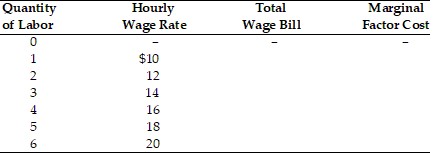 In the above table, if the marginal revenue product is $14, how many workers will the profit maximizing monopsonist hire?
In the above table, if the marginal revenue product is $14, how many workers will the profit maximizing monopsonist hire?
A. 2
B. 3
C. 4
D. 5
Answer: A
You might also like to view...
Any target value of the nominal interest rate chosen by the Federal Reserve implies a specific value for ________.
A. potential output B. the budget deficit C. government purchases D. the money supply
How is the concept of present value useful in deciding whether or not to undertake an investment project?
What will be an ideal response?
Suppose the following two events occur in the domestic market for radiologists:
a. Some hospitals are outsourcing some radiology services such as reading x-rays. b. Some medical schools have closed down their radiology departments as fewer students enroll in this field. What is likely to happen to the equilibrium wage and quantity of radiologists following these two events? A) The equilibrium wage falls and the effect on equilibrium quantity of radiologists is indeterminate. B) The equilibrium wage and the equilibrium quantity of radiologists fall. C) The equilibrium wage and the equilibrium quantity of radiologists rise. D) The equilibrium quantity falls and the effect on the equilibrium wage of radiologists is indeterminate.
Offer an economically logical argument as to why the benefits per trip are progressively higher with the categories of fish shown?
HOW MUCH IS CLEANER WATER WORTH TO MARINE SPORTFISHING? Most water quality research focuses on a particular water body or region for the context of its analysis. Such is the case for a University of Maryland study supported by the EPA that analyzed the coastal region from New York to south Florida (excluding the Florida Keys). The location was motivated by the economic activity being studied: marine sportfishing. Eighty percent of all East Coast marine sportfishing takes place in the area targeted by the study. Furthermore, the region is one where there are active pollution control initiatives and where management plans for recreational fisheries are in place. The objective of this university research was to develop a database and a procedure that can be used to estimate the economic value of two related factors: access to marine sportfishing and changes in the catch rate of various species, where the catch rate is the average number of fish caught per fishing trip at a given site. The link between these two factors and economic benefits is a logical one. Water quality policy reform can improve the catch rate, which in turn will affect fishermen's decisions about where to fish, what species they fish for, whether they fish from the shore or from a boat (called the fishing mode), and even how often they go fishing. By measuring these changes in fishermen's behavior, researchers can make the link to a monetized benefit measure of improved fishing conditions that can be achieved through tougher pollution controls. To determine catch rates, the analysis used survey data collected by the National Marine Fisheries Service. Three categories of catch rates are defined by type of fish: big game fish (e.g., marlin and tuna), small game fish (e.g., bluefish and mackerel), and bottom fish (e.g., snapper and grouper). Three different preliminary benefit estimates were reported by the EPA: • A 20 percent increase in the catch rate of small game fish for both fishing modes at all sites would increase the average benefit of each fishing trip by $0.33. • A 20 percent increase in the catch rate of bottom fish by boat would increase the average benefit per trip by $1.27. • A 20 percent increase in the catch rate of large game fish would yield an increase in benefits of $1.56 per trip.